This post is part of a series about body proportions in art (part 1) and in the Voynich manuscript (part 2). We have seen that the Voynich nymphs have unusual proportions, different than those found in classical art and real life: they are a bit over four heads tall, which makes them extremely stunted. Additionally, it appears that the use of these proportions is consistent throughout the manuscript, which means that they cannot be blamed on a lack of drawing skills.
In this third installment, I will compare the median nymph proportions to those found in a range of other art forms and manuscripts.
LIST OF ADDITIONS:
- 11/10/2016: Pal. Lat. 1369
Before we start comparing images, a couple of remarks:
- I don’t believe MS Beinecke 408 is the creative product of a medieval author. Still, I am eager to find parallels for the nymphs’ consistent proportions in medieval manuscripts as well, since such findings could only improve our understanding of the transmission.
- My aim is to show that body proportions are an important consideration in a comparative analysis of images. This does not mean that finding matching proportions alone can prove or disprove anything. But they do have to be taken into account, and similar proportions will strengthen one’s argument.
- There are millions of depictions of the human body from the 15th century and before. If you are a Voynich researcher, it is likely that I will not discuss your preferred source. In case you think I missed an important candidate, please do let me know and I will gladly add it in a future installment.
I came up with a straightforward and visually appealing way to test similarity of proportions. First, I lined up some nymphs with their heads nicely between two lines – top of he skull to chin. Then I added the other guidelines over their navels, knees and one for the “floor”. The nymphs are of course a bit different in size, so I put the lines somewhere in the middle.
The most important lines are those that frame the head and the one that marks the bottom. Like this, all I have to do is resize any given figure to put its head between the top two lines, and we can see the rest. The image below shows how it works.
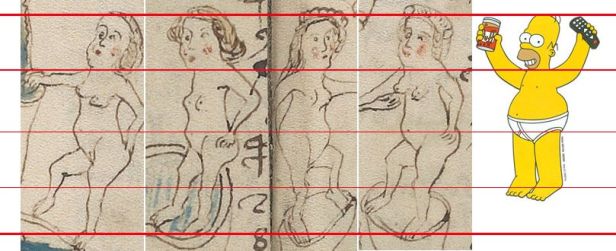
Like this, we can see at a glance that Homer Simpson only reaches down to the knee line, making him a head more compact than the nymphs.
Collection of the Samples
Since I have recently devoted a lot of time to studying ancient antecedents for the Voynich nymphs, I realized that my collection of big-heads was skewed. That is why I asked the members of the Voynich Ninja forum for some examples from medieval manuscripts as well. Even though I believe the original version of these drawings was likely made in a Greek- or Roman-Egyptian cultural setting, all attestations of these proportions are valuable in understanding their transmission.
Since I am not ready yet to place the examples in a meaningful order, I will discuss them chronologically. This does not imply any assessment of their relevance. The chronological order is problematic in itself because many of these sources have in common that they are based on older models, so it might give a false sense of evolution. Yet it’s the most neutral criterium available.
I will stress once again that the collection is extremely limited at the moment and will likely be expanded later. Also, and I will put this in nice colored letters so even skimmers will read it, bodily proportions are just one possible indicator of a similar style. All I am doing is mapping the occurrence of these proportions, but all by themselves they do not prove any connection. Establishing that would take further study, taking more variables into account.
Let’s get to it, then, in chronological order:
1400 BCE, Egyptian: alabaster figure of a Nubian servant
This item functioned as a container for ointments, shaped like a Nubian dwarf carrying a large vase. I consider 1400 BCE too early to have had any direct influence on the origin of the Voynich imagery, but the artefact is still interesting. We can see that he is around four heads tall, a bit under Voynich average. The way his arm is shaped is reminiscent of a number of Voynich figures, as well as the bumpy head, protruding belly and wide legs.
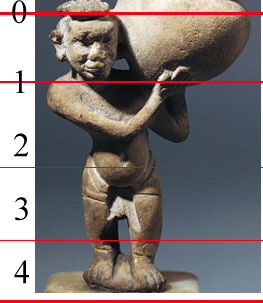
The Egyptians had a number of dwarf deities, who were stylized, like all classical Egyptian figures, making them look more like demons or goblins. Objects like this one, however, made for everyday use, show a relatively realistic depiction of a person with dwarfism. As we learn from a similar item’s description at the Brooklyn Museum, “the ancient Egyptians regarded short stature as a mark of divinity. They associated the physical characteristics of achondroplasia (a type of dwarfism) with the sun god Re.”
And from the Walters Art Museum: “Despite, or because of, their deformity, dwarfs held a respected position in Egyptian society and were often credited with magical powers.”
This is why all the way until the Roman period, we see figures with dwarf-like proportions in “popular” items, like amulets, household objects and provincial art. People associated these figures with the cycle of the Sun, and thus with rebirth, immortality and fertility.
743–712 BCE, Nubian: Winged Goddess Pectoral

These figures were very common during the Nubian reign over Egypt. There are several similarities to Voynich figures, but those are likely coincidental.
Ptolemaic Period, Egypt: various objects
From left to right: Dancing Dwarf, 3rd century BCE; Isis, Horus and Nephthys; Female figure, 1st century BCE.
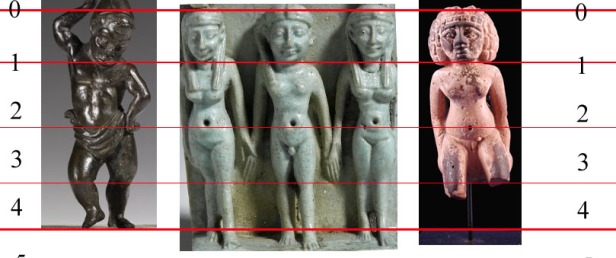
Here we see clearly that the figures centre and right are proportioned like the dwarf on the left, all very similar to the Voynich nymphs. These figures are associated with rebirth and fertility. Especially in the central triad, the nymph navel line and knee line are on the right place. Note also how these figures are nude, apart from headgear.
48 – 25 BCE, Indo-Scythian: coin of Azes I
Diane O’Donovan has noted a similarity between the stylistics of Voynich nymphs and figures found on coins of the easternmost Hellenized kingdoms. The following is one example, found here.
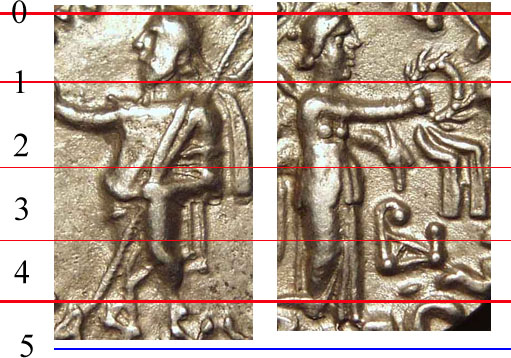
2nd century CE, Roman Egypt: the Tomb of Petosiris in the Dakhla Oasis
The painted tomb of Petosiris is decorated in a variety of styles. Some see this as a result of its provincial style, while others note that this “mingling of visual vocabularies illustrates the complex cultural milieu of Roman Egypt”. As can be expected in this hybrid, provincial set of images, there is quite some variation in the figures’ proportions.
Of special interest for this study are a number of figures found on the ceiling, representing constellations, supported on all corners by winged women. These, and the constellation figure in the middle, are close to Voynich proportions.

Also note, in the same tomb, the pretty stars and – gasp – blond people.
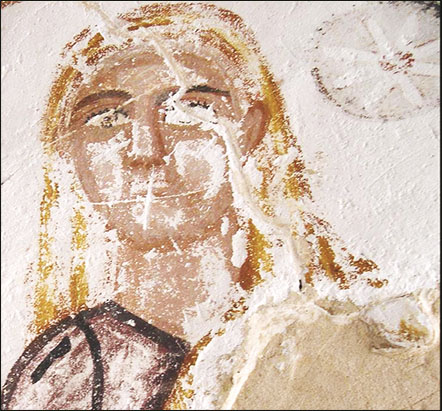
813-820, Byzantine: Vat. Gr. 1291
This manuscript was suggested by Sam G., because it is often referenced in Voynich studies. I measured two nude figures from the concentric circles, and one additional figure from fol.22.
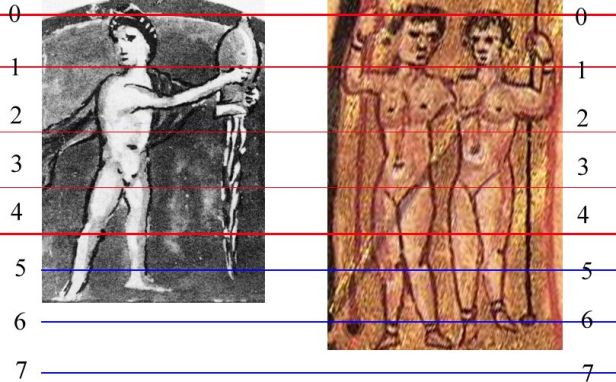
Proportions in this manuscript are not as consistent as in the Voynich. Even the Twins, ironically, don’t have the same proportions – which might be explained by place constraints. Still, they are also significantly less stocky than the VM nymphs. The fol. 22 figure (left) is perhaps more similar. He measures about a full head taller than the nymphs, and the way his arms are drawn is reminiscent of some VM figures. The VM bottom line (between 4 and 5) is a bit below his knees, while in the Twins it falls above the knees.
11th century, French : BNF MS Lat. 7028
This manuscript has been mentioned in relation to Voynich studies a number of times before, and it contains a number of fascinating elements – a non-standard Zodiac series for one. What concerns our current study is that some of the human figures match the nymph proportions well – and other stylistic elements to some extent. Just compare the way the legs are drawn.

Now, if we put them on our proportion scale, the result is impressive:
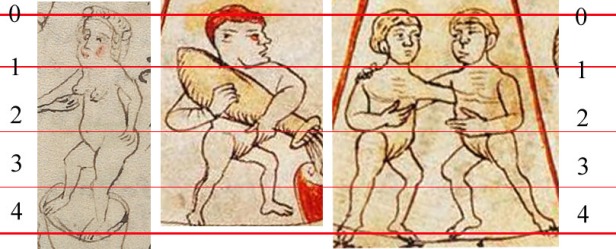
One thing to note is that the Voynich manuscript is more consistent in its style, while Lat. 7028 shows a variety of influences. Still, the resemblance with the three figures reproduced here is striking.
11th century, Coptic. Woven Tapestry
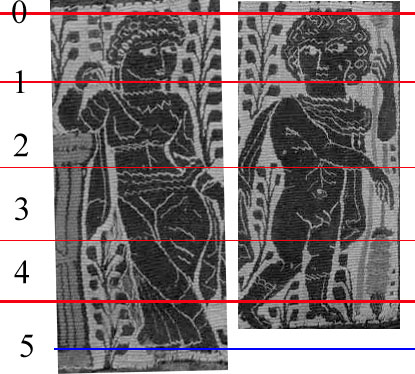
1184, Italy: Modena Cathedral
Ellie Velinska suggested an interesting example from Modena, northern Italy. The sculpted figures on its Romanesque cathedral have rather large heads. Proportions are less regular than the VM nymphs, ranging from 4.1 to 6.1 heads in the figures measured, but some figures could fit perfectly in the Voynich proportion wise.
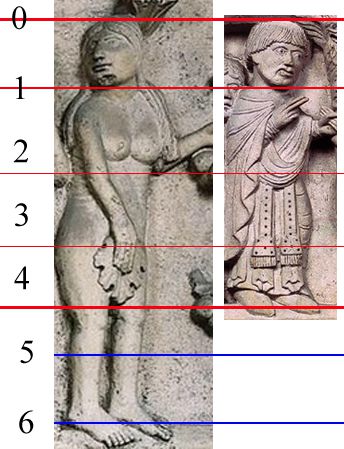
As you can see, the priest could start converting nymphs right away without a problem, while Eve would be a bit out of… proportion.
14th century, Italian: BNF Lat. 8161 and Cod. Bodmer 135
Copies of De balneis puteolanis are often proposed as parallels for Voynich images because they depict naked people bathing and have a relatively secular approach to the subject. Still, the Balneis does reach a much higher Jesus-per-folio average than the VM.
There are many Balneis copies, so I selected the first two results brought up by Google. Both are 14th century Italian works. Figures from both manuscripts are over a head taller than the nymphs. The Voynich figure looks like a Smurf compared to the Bodmer 135 giant.
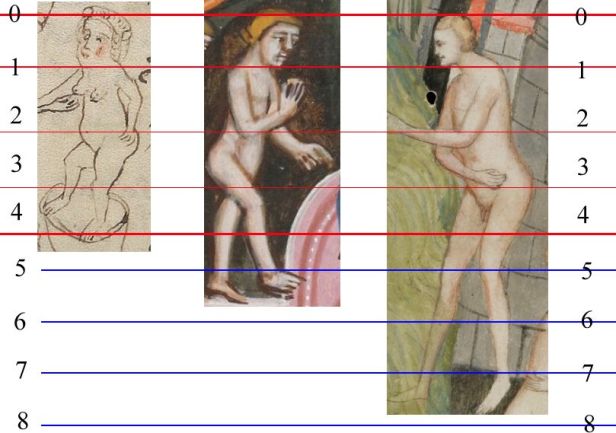
1361, Catalonia: MS LJS 57
This Hebrew manuscript is regularly cited by Diane O’Donovan because of its overall stylistic resemblance to the VM nymphs. Proportion wise, they are a bit more elongated than Voynich nymphs, standing one head taller.

Looking at the way the figures are positioned and the way limbs and faces are drawn, the resemblance to the VM style is noticeable.
Mid 15th century, Germany (al-Sufi translation): Pal. Lat. 1396
The Gemini illustration in this manuscript was noted by Darren Worley to be very similar to the Voynich pair. When we resize the figures for matching head proportions, we see something remarkable. The Pal. Lat. 1396 pair is given exactly the same proportions as the VM female, while the VM male is completely different.
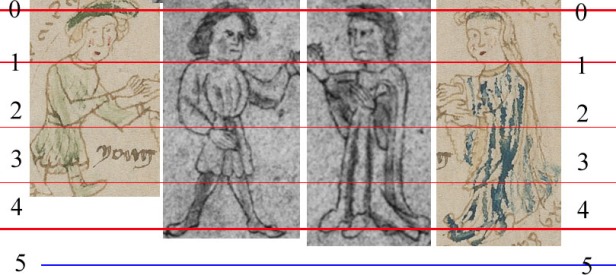
1457, Paris: The Hague MMW 10, A, 11
This manuscript was proposed by Ellie Velinska. Some of its imagery is similar to that in the VM, notably a series of naked people in a circle. Even though these figures are drawn at a relatively small scale, their height is consistently near six heads. Note how the Voynich bottom line runs nicely through their knees. The figures are drawn a bit more lifelike than Voynich nymphs.
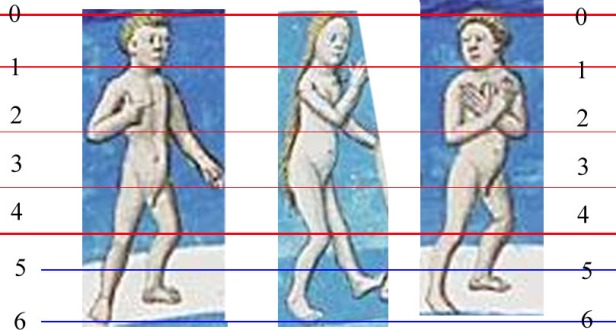
1459, Ms 793 Krakow, Biblioteka Jagiellonska (Picatrix)
This group of manuscripts that became known under the peculiar name Picatrix has a complex history, which is worth a blog post all in its own. There are several remaining copies, at least one of which contains a large number of illustrations. The origin of the images is not very clear. Forum user Yulia May pointed out that some of these illustrations might prove relevant for the current study.
There are two very distinct art types in this manuscript. The first is found in a large series of images near the end, and the other is in a single illustration of three figures around the middle. They clearly have a different origin, though they are both rather big-headed. Let’s start with the first style, the most common one in this manuscript.
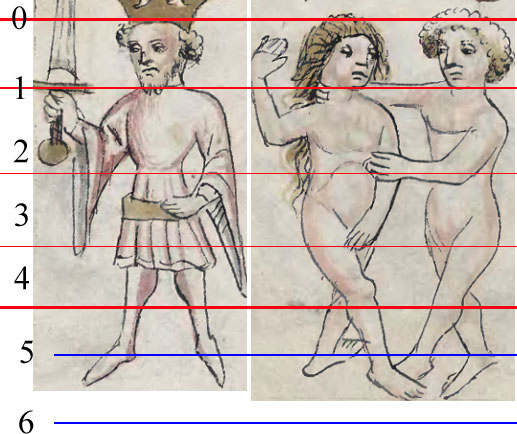
The proportions of these figures are very similar to those in the Hague manuscript, with the Voynich bottom line about at knee height, putting the figures somewhere between normal and Voynich proportions.
The second style is remarkably different. There are only three figures, standing in a row. When we resize them to the same head size, we see that their proportions are not regular. Let’s start with the “king and queen”.
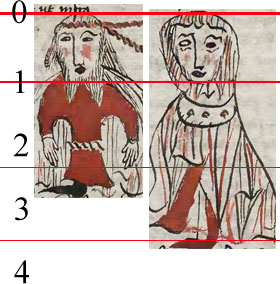
The king is not even three heads tall, and the queen reaches just past the Voynich knee line, making both of them more compact than any Voynich figure.Also, they both have only one foot (?).
Their other companion, though, sits well within the Voynich range. Let’s put him between the Archer and the male twin. He’s a bit hard to measure because of his voluminous curls, so I had to estimate where the top of his head would be.
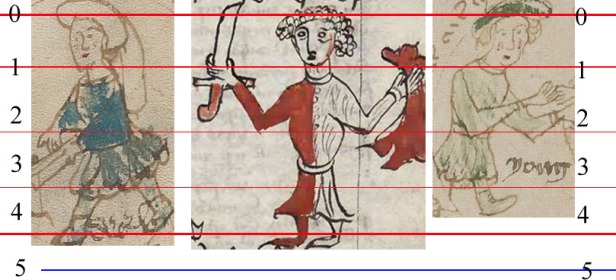
Guesswork aside, this image should make it clear that the figures are similarly proportioned. I find especially the parallels with the Twin striking: white collar at neck and sleeves, very low belt, short legs, awkwardly hooked arms. Of course there are stylistic differences as well, especially in the way the Krakow figures’ faces are drawn. Considering the inconsistency in these figures’ proportions, an argument could be made that they are just badly drawn and that resemblances are coincidental.
1949-present, Denmark: A Lego Man
Finally, forum member Sam G. also suggested “a Lego man”, which turns out to be one of the best matches. Who knew?
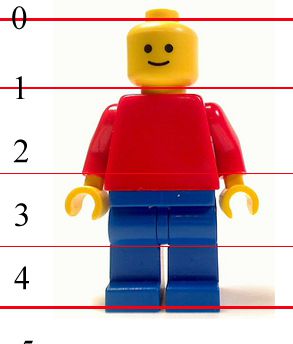

Koen,
It’s a pleasure to see detailed analysis of this sort being engaged.
LikeLike
Ahh I just realized I forgot a Coptic example. And a dozen others. It’s a work in progress 🙂
LikeLike
.. and of course – trust Sam! 😀
LikeLike
– though he’s just adding another example of the proportions to which the European tradition adheres, whether the image is literalist or not. And those are the proportions *not* seen for most of the Voynich ‘nymphs’, we agree.
LikeLike
Koen,
My poor old ten-yr-old laptop is dying. I see letters and corrections appear on the screen which don’t appear when published. So let me try again.
—-
One possible explanation which might be worth investigating – if the evidence is sufficient – to explain the ‘big head small limbs’ phenomenon, and why it occurs chiefly in the south-eastern corner of the Mediterranean, and then in the Greco-Bactrian region: that the use of those proportions began in African customs which influenced Egypt and the region around Barca, and were thus carried with the deportees from Barca, into the region that we know as ‘Bactria’. Greek sources tell us that the name ‘Bactria’ came from the Libyans of Barca.
In addition – thinking of the Kiev figures – there are hints of quite ancient connection between the Black Sea and Egypt.
Herodotus says a group of people there looked Egyptian (i.e. African) to him. Later – in the earliest years of Hellenistic Alexandria – a town in the Black Sea whose people claimed to have first been settled from Egypt, provided the deity who after being re-named and given another body became ‘Serapis’.
I don’t think one could argue that the Kiev figures descend directly from the old monumental Egyptian style. It might be possible to argue that the people of the ancient colonies in that region were influenced by the style – a sort of decayed Egyptian style – that you have already illustrated during the Roman period.
The grain run between the Black Sea and Egypt constantly connected the two termini, anyway, though the antiquity of that trade might need to be established.
I don’t know if the BlackSea-Egypt line’s cultural history has ever been studied in much depth, but the history of the maritime links and the grain ships have been.
LikeLike
The “Egyptian settler” line of thinking would certainly explain a lot. And what you say about Serapis makes me believe more in the importance of BNF Lat 7028. As a different descendant of the VM source, that is.
About those Kiev statues – did you notice their necklaces? They look a lot like the Egyptian menat or aegis…
LikeLike
Hi, Koen: Have you ever looked at the Edda Oblongata? It’s an Icelandic manuscript from the late 1600s. The people look Voynich – like to me, plus there are fantastic plant-like extensions in the drawings (see, e.g. f42v which is a depiction of Valhalla). It’s all probably coincidental minimal drawing skills type of thing but l found the parallels interesting.
http://handrit.is/en/manuscript/view/is/AM04-0738
Thanks for the interesting work!
LikeLike
Sorry – that’s 41v for Valhalla – and don’t miss the mythical male red deer named “Dain” that eats off the left side of the tree of life a few pages later. 🙂
LikeLike